Features
Constitutionalism, Governance, and the People

by Prof. Savitri Goonesekere
Coming to the University of Peradeniya is always a special experience. It brings back memories of carefree student days in a perfect environment for friendship and learning. Who can forget the glorious “yellow showers,” the winding Galaha Road, the lawn mowers on fresh grass, “sunset and evening star” and the flute music? The memory is also tinged with sadness, for the troubled times experienced on this beautiful campus, the changes in that familiar environment that have taken place, over threescore years and ten. The changes themselves reflect my own experience, and that of all of us as citizens, on the governance of this country and our universities. I thank the Law Department for inviting me, an alumnus of the first Department of Law in our public university system, to deliver the inaugural Sir Ivor Jennings memorial lecture. Sir Ivor Jennings, the founding Vice Chancellor of the first national University of Ceylon and its twin successor the University of Peradeniya can also be described as one of the founders of Constitutionalism and governance in both the country and the national university system of Sri Lanka.
The inauguration of a lecture series in Sir Ivor Jennings’ memory by the Law Department can also be an occasion to reflect on his life and times in this country, and the changes we have witnessed in these areas. The topic I have chosen for this evening’s lecture is a tribute to a scholar and administrator of a colonial era, whose ideas are an important resource, as we respond to contemporary realities of governance in our country and the university system.
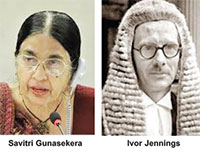 Let me clarify at the outset especially to students, that I am not one of the oldest living students of Sir Ivor Jennings. I was not a student of Sir Ivor, when he lectured in the Law Department, and was Vice Chancellor of the University of Ceylon in Peradeniya. Indeed, I discovered I was a prize winner in my secondary school, Ladies’ College, when Sir Ivor gave the keynote speech at our annual prize giving. I am sure that I was much less impressed with him, than I was with senior student Kumari Jayawardene, speaking passionately on a school platform on worker’s rights. I read through his classic works “The Law and the Constitution,” and “Cabinet Government,” and Jennings and Tambiah on “The Legal System of Ceylon,” very much in the spirit of plodding through “recommended readings.” Constitutional law paled in comparison with other law courses that inspired my interest. However, there were anecdotes that we heard about Sir Ivor. We heard that he was a “student friendly” former Vice Chancellor, quite the contrast of fearsome Sir Nicholas Attygalle. I recall my first examiners’ meeting in his room (the Vice Chancellor chaired the Board Meeting for the award of degrees.) Sir Nicholas looked at me with a steely eye and said “who may I ask are you?” Quite a contrast to Sir Ivor, who sent out a staff circular, which said, “My address is now 18, Aloe Avenue, Colpetty. A drink is always available for members of the staff who feel thirsty or otherwise sociable.”
Let me clarify at the outset especially to students, that I am not one of the oldest living students of Sir Ivor Jennings. I was not a student of Sir Ivor, when he lectured in the Law Department, and was Vice Chancellor of the University of Ceylon in Peradeniya. Indeed, I discovered I was a prize winner in my secondary school, Ladies’ College, when Sir Ivor gave the keynote speech at our annual prize giving. I am sure that I was much less impressed with him, than I was with senior student Kumari Jayawardene, speaking passionately on a school platform on worker’s rights. I read through his classic works “The Law and the Constitution,” and “Cabinet Government,” and Jennings and Tambiah on “The Legal System of Ceylon,” very much in the spirit of plodding through “recommended readings.” Constitutional law paled in comparison with other law courses that inspired my interest. However, there were anecdotes that we heard about Sir Ivor. We heard that he was a “student friendly” former Vice Chancellor, quite the contrast of fearsome Sir Nicholas Attygalle. I recall my first examiners’ meeting in his room (the Vice Chancellor chaired the Board Meeting for the award of degrees.) Sir Nicholas looked at me with a steely eye and said “who may I ask are you?” Quite a contrast to Sir Ivor, who sent out a staff circular, which said, “My address is now 18, Aloe Avenue, Colpetty. A drink is always available for members of the staff who feel thirsty or otherwise sociable.”
Besides, we were the beneficiaries, the “nidahas adhyapanaya labee,” the early students to enjoy the beautiful learning environment that we knew Sir Ivor had struggled to create for us all, despite his implacable objections to the Kannangara policies of free education.1 We enjoyed a peaceful conflict-free learning environment that had been created according to Sir Ivor Jennings’ vision of what university life should be.
When we were undergraduate, some of us women students who refused to boycott classes were met with hoots and whistles when we went for lectures. Yet our “black leg” voices were heard at a huge meeting held under the glorious tree in front of the Senate building, and the strike was over. This meeting was presided by senior politician Dr Sarath Amunugama. Barely a decade later when I was on the staff of the Law Department which had by then moved to Colombo, a student in one of the halls of residence in Peradeniya leapt from an upper floor during ragging, and was crippled for life. My students in Colombo told me they would be assaulted if they followed my advice and expressed their objections to boycotting classes “in sympathy” with the students suspended over the incident. The beautiful and conflict free learning environment that Sir Ivor Jennings, the founding Vice Chancellor had strived to create was already beginning to crumble, a decade later.
Sir Ivor’s commitment to academic excellence meant that high academic standards were maintained in the years that followed his term in office. Products of the University of Peradeniya at the time, and not just the top tier, achieved success and eminence in diverse fields. The equality of access that Sir Ivor feared would result in a “levelling down” of academic quality with free education, in fact gave equal access to a good education for those who entered through the portals of the University of Ceylon, Peradeniya.
Institutional memory in this country is very short. It is only the University of Peradeniya that has sustained our memories of Sir Ivor Jennings’ contribution to our university system and the governance of this country. When I served as Vice Chancellor of the University of Colombo there was no photograph of Sir Ivor Jennings in College House, which he had occupied for many years, or any other building. I obtained a faded copy of a black and white photograph from Prof. Kapila Goonesekere, former Vice Chancellor of Peradeniya University; nothing like the imposing painting of Sir Ivor by David Paynter that adorns the walls of your Senate room.
Sir Ivor Jennings and the Road to Peradeniya
The life and times of Sir Ivor Jennings are documented in his own autobiography, published with an introduction of great professional skill, and with admiration, by the distinguished librarian, late Ian Goonetilleke. This is a rich resource. Professor Lakshman Marasinghe’s essay in a book on legal personalities supplements the autobiography with interesting insights on his work as a legal scholar and jurist. Sir Ivor was a controversial figure during the time he spent in the island, then Ceylon, where he had an important impact on public life and the education sector. His views and his engagement in the political life of the country, attracted criticism, but also admiration.
Sir Ivor began his tenure as Vice Chancellor of the University of Ceylon in the University of Colombo of today. He recalls in his autobiography how the law creating the University of Ceylon was passed on April 2, 1942, three days before the Japanese air raid on Colombo. He unfurled the university’s flag on June 12 on the grounds of College House. He remarks wryly, “being a little sentimental, [seeing] the flag sagging at one end [he] climbed the tower and adjusted it with a safety pin.” No Kandyan dancers, drummers and fanfare at this event.
An educationist of colonial times like Rev. W S Senior of Trinity College Kandy, when he left the island, could record in poetry, “my soul you will break with longing – it can never be goodbye.” Sir Ivor, the legal scholar, jurist, educationist, and administrator, could say with somewhat clinical objectivity, “I am in no way tied to Ceylon and can leave when the spirit moves.” Yet he had a vision and commitment to laying the foundation for a national university, which he believed could become “one of the finest small universities in the world.
Sir Ivor believed that a residential University in an attractive environment was one of the essential attributes of a great university. He was, as he describes himself, “a Cambridge [university] man.” His appreciation of the physical environs of that University created a desire to build a university campus on a site in Peradeniya, which he thought was one of “the most beautiful environments in the world for a university.”
The architecture and landscaping of this university continues to be a model for well-planned and attractive landscaped surroundings, creating a near perfect environment for scholarship and learning. His contribution in this regard has outlived Sir Ivor, even if the values on governance and university education that inspired him have been challenged in the realities of our nation’s post independence experience. However, if Sir Ivor’s surprising inclination to “pull down” College House and construct a women’s hostel had been realised, Colombo University would not have even that colonial heritage of great beauty on its campus surrounded by a wilderness of concrete box like structures.
Sir Ivor had a spectacular student career, receiving first class honours at every level. His approach to study is perhaps relevant to all law students who want to achieve academic honours in their law schools. He was a disciplined workaholic, even as a student. He saved his lunch money to buy books, and “study took precedence over everything.” He studied with “regularity and consistency,” developed a timetable for this, studied the “technique of examinations,” striving to obtain “not only a first, but a brilliant first.” Yet he did not believe only in examination success and paper qualifications. He believed that a residential University could create an environment for extra curricular activities providing an education that was interdisciplinary, stimulating interest in poetry, philosophy, and the arts. His own scholarship crossed the boundaries of law, politics, and political science. He gave up mathematics to study law. He thought “the boundaries between academic subjects very artificial, for knowledge … knows no boundaries.”
The Law Department of Peradeniya is the first to integrate an interdisciplinary perspective, an initiative very much in harmony with Sir Ivor’s concept of a good legal education. Law schools, have, in general adopted what legal theory in the Anglo American tradition describes as “Austinian positivism” that teaches students how to learn and analyse the content of laws. However, in the early years the focus on reference and reading meant that students read widely and understood the core norms and concepts that linked law and administration of justice. This approach produced lawyers of great professional skill and eminence at a time when legal education was exclusively in English. It has had serious drawbacks for teaching and research in a challenging environment where very little literature is available in local languages, and most lawyers obtain a monolingual legal education with lecture notes in Sinhala or Tamil. Sir Ivor was uncompromising in his commitment to excellence in teaching and research. When my husband, as one of the young lecturers in the Law Department, was to go to Oxford for post-graduate studies, Sir Ivor advised him to read for a taught post-graduate degree in Civil law, (the BCL). Undertaking research he said, was the post qualification obligation of all University teachers, and a law teacher could then apply for a higher doctorate! This advice was clearly based on his personal experience as a scholar and jurist.
Though Sir Ivor’s scholarship and vision span law, politics and an interdisciplinary perspective, he was cynical about all “isms” – Marxism, nationalism, communalism, considering them political rhetoric. He had a poor and mistaken impression of the country’s cultural heritage. He thought that transferring the University to Peradeniya could help “a cultural desert in Ceylon to blossom like a rose.” Yet he established a Faculty of Oriental Studies in the University of Ceylon, encouraged the development of these disciplines, and stressed the importance of scholarship and learning that was sensitive to local social and economic realities. He supported the creation of a university endowment fund, and a museum for sculpture, paintings and objects of art. He thought “pious benefactors” from the private sector would contribute to such a fund, and wanted the sales of his autobiography used for such an initiative. I believe that late Ian Goonetilleke who treasured his own stunning collection of artworks by George Keyt and many other reputed Sri Lankan artists, was inspired by Sir Ivor’s vision to donate this priceless collection to the University of Peradeniya. An Ivor Jennings memorial lecture is surely an occasion to also pay tribute to that joint vision. Universities are receiving substantial funds from Government to improve their infrastructure. Is it not possible to give a museum project maximum priority in university planning, supplementing this with support from “pious benefactor” alumni in business and the professions?
Values on university autonomy free from political interference were very much the foundation for Sir Ivor’s vision of university education. The 1942 University Ordinance, which he drafted, also incorporated the concept. This law established Councils, Senates and Faculty Boards, modelled on the institutional arrangements of British universities. For Sir Ivor, the institutions, (still embedded in our university system, in 1978/1985 legislation), could provide academics with the tools to resist abuse of political and official authority and interference in university administration. When the University of Ceylon Bill was being debated in the legislature, Sir Ivor who sat behind the Minister C.W.W. Kannangara, drafted quick amendments that prevented clauses being introduced that could erode university autonomy. Though he and the Minister opposed each other in the Committee on Education on the proposals for free education, they shared the same perspective on the importance of maintaining the autonomy of universities in the area of higher education.
Academics from the university community in Peradeniya gave leadership when university autonomy was under attack in the late 1960s and 1970s. The current Universities Act with strong provisions on this principle, was adopted once again in 1978 with the contribution of senior academics from Peradeniya University. It was intended to restore the autonomy of universities. It was unfortunately amended in 1985, creating new provisions on the appointment and dismissal of Vice Chancellors with an expanded regulatory role for the University Grants Commission. These changes undermined the authority of the highest university bodies (Councils and Senates) and has encouraged political interference.
Two university Vice Chancellors have been recently removed without, it is alleged, following even the required procedures. A few academics have publicly challenged these actions. But we have, in general, become accustomed to erosion of university autonomy by political authorities, even though the institutional arrangements introduced in 1942 by Sir Ivor continue to be part of our university system. State universities are being blamed for not sustaining excellence in education and contributing to human resource development. No link is made to the toxic impact of politicization of university education.
Constitutionalism and the Sri Lankan People
Constitutionalism, as law students know, refers to the theoretical underpinnings of Constitutional law. The theories in turn impact on the institutional arrangements for governance, and the concepts incorporated in Constitutions. Constitutions and their theoretical concepts are often dismissed as irrelevant for the People. Yet, governance impacts on peoples’ lives. Constitutions and the people are therefore all connected.
Nelson Mandela referring to Constitution making in South Africa in 1996, said that a Constitution is “a law that embodies the nation’s aspirations.” Sir Ivor Jennings wrote an Article published in the Ceylon Daily News three decades earlier in 1962 commenting that, “any lawyer can draft a Constitution for anywhere. The difficulty is to persuade a people to make it work.” The “aspirations” justification for Constitution making in Mandela’s words, places the concept of the “Sovereignty of the People” at the centre of Constitution making. Sir Ivor’s comment focuses on the responsibility of both rulers and the governed to make Constitutions work.
The weeks and months prior to the Presidential elections 2019 witnessed an outpouring of public anger against politicians and our legislators. A constant refrain is the failure and defects of democracy, and Constitutionalism as lawyers know it, and a desire to replace it with new institutions and “strong individual leadership.” Another discourse calls for rejection of any links to Constitutional norms and standards derived from what are described as implanted and alien “colonial” or “Western elitist” norms and standards of governance. The idea of governance based on “jathika chinthanaya” or national conscience advocated the need to link political ideology with a local, rural, traditional culture. This has now been reinvented in a new discourse on the need to reject for all time “Suddha law.” This is a phrase used by the monk Gnanasara when he disrupted Court proceedings and was convicted of contempt of court. The public display of abuse of power, arrogant, irresponsible and corrupt governance, selfish political leadership and waste of national resources despite regime changes, has created a demand by some for a complete rejection of Constitutional theories and the institutions of governance.
Such trends are visible in other countries too. The furore over Brexit in the United Kingdom and the conflict between Parliament and the Prime Minister is sometimes traced to the absence of a written Constitution with specific provisions on how to cope with challenging problems of governance. Sir Ivor Jennings, the British constitutional lawyer and jurist, drafted written Constitutions for many countries, and wrote his seminal work on “The Law and the Constitution.” He would have contested the suggestion that Constitutional law and Constitutionalism could only be embedded in a written Constitution. From his perspective, governance that limited State power, and based on written or unwritten Constitutions was the responsibility of the rulers and the governed.
(Excerpted from “Inaugural Sir Ivor Jennings lecture of the Department of Law University of Peradeniya,” included as part of the new book “Perspectives of Constitutional Reforms in Sri Lanka” edited by Dr. Hiran W. Jayewardene and Sharya Scharenguivel. Published by International and Contemporary Law Society).
Features
Minds and Memories picturing 65 years of Sri Lankan Politics and Society
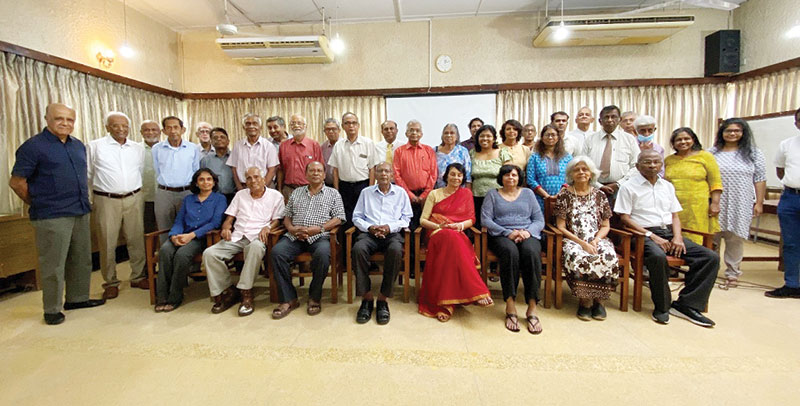
Last week I made mention of a gathering in Colombo to remember Kumar David, who passed away last October, as Comrade, Professor and Friend. The event was held on Saturday, April 5th, a day of double significance, first as the anniversary of the JVP insurrection on 5th April 1971, and now the occasion of the official welcome extended to visiting Indian Prime Narendra Modi by the still new JVP-NPP government. The venue was the Ecumenical Institute for Study and Dialogue (EISD) on Havelock Road, which has long been a forum for dialogues and discussions of topics ranging from religious ecumenism, Liberation Theology and Marxist politics. Those who gathered to remember Kumar were also drawn from many overlapping social, academic, professional and political circles that intersected Kumar’s life and work at multiple points. Temporally and collectively, the gathering spanned over six decades in the evolution of post-independence Sri Lanka – its politics, society and the economy.
Several spoke and recalled memories, and their contributions covered from what many of us have experienced as Sri Lankans from the early 1960s to the first two and a half decades of the 21st century. The task of moderating the discussion fell to Prof. Vijaya Kumar, Emeritus Professor of Chemistry at Peradeniya, who was a longtime friend of Kumar David at the university and a political comrade in the LSSP – especially in the Party’s educational and publication activities.
Vijaya Kumar recalled Kumar David’s contributions not only to Marxist politics but also to the popularization of Science that became a feature in several of KD’s weekly contributions to the Sunday Island and the Colombo Telegraph. Marshal Fernando, former and longtime Director of the EISD welcomed the participants and spoke of Kumar David’s many interactions with the Institute and his unflinching offer of support and advice to its activities. EISD’s current Director, Fr. Jayanath Panditharatne and his staff were extremely helpful.
Rohini David, Kumar’s wife of over 50 years, flew in specially for the occasion from Los Angeles and spoke glowingly of Kumar’s personal life as a husband and a father, and of his generosity for causes that he was committed to, not only political, but also, and more importantly, educational. An interesting nugget revealed by Rohini is the little known fact that Kumar David was actually baptized twice – possibly as a Roman Catholic on his father’s side, and as an Anglican on his mother’s side. Yet he grew to see an altogether different light in all of his adult life. Kumar’s father was Magistrate BGS David, and his maternal grandfather was a District Judge, James Joseph.
Kumar had an early introduction to politics as a result of his exposure to some of the political preparations for the Great Hartal of 1953. Kumar was 12 years old then, and the conduit was his step-father, Lloyd de Silva an LSSPer who was close to the Party’s frontline leaders. From a very young age, Kumar became familiar with all the leaders and intellectuals of the LSSP. Lloyd was known for his sharp wit and cutting polemics. One of my favourite lines is his characterization of Bala Tampoe as a “Lone Ranger in the Mass Movement.” Lloyd’s polemics may have rubbed on Kumar’s impressionable mind, but the more enduring effect came from Lloyd’s good collection of Marxist books that Kumar self-admittedly devoured as much as he could as a teenager and an undergraduate.
Electric Power and Politics
Early accounts of Kumar’s public persona came from Chris Ratnayake, Prof. Sivasegaram and Dr. K. Vigneswaran, all Kumar’s contemporaries at the Engineering Faculty that was then located in Colombo. From their university days in the early 1960s, until now, they have witnessed, been a part of and made their own contributions to politics and society in Sri Lanka. Chris, a former CEB and World Bank Electrical Engineer, was part of the Trotskyite LSSP nucleus in the Engineering Faculty, along with Bernard Wijedoru, Kumar David, Sivaguru Ganesan, MWW Dharmawardana, Wickramabahu Karunaratne and Chris Rodrigo. Of that group only Chris and MWW are alive now.
Chris gave an accurate outline of their political involvement as students, Kumar’s academic brilliance and his later roles as a Lecturer and Director of the CEB under the United Front Government. Chris also described Kumar’s later academic interest and professional expertise in the unbundling of power systems and opening them to the market. Even though he was a Marxist, or may be because of it, Kumar had a good understanding of the operation of the market forces in the electricity sector.
Chris also dealt at length on Sri Lanka’s divergent economic trajectories before and after 1977, and the current aftermath of the recent economic crisis. As someone who has worked with the World Bank in 81 countries and has had the experience of IMF bailout programs, Chris had both warning and advice in light of Sri Lanka’s current situation. No country, he said, has embarked on an economic growth trajectory by following standard IMF prescriptions, and he pointed out that countries like the Asian Tigers have prospered not by following the IMF programs but by charting their own pathways.
Prof. S. Sivasegaram and Dr. K. Vigneswaran graduated in 1964, one year after Kumar David, with first classes in Mechanical Engineering and Civil Engineering, respectively. Sivasegaram joined the academia like Kumar David, while Vigneswaran joined the Irrigation Department but was later drawn into the vortex of Tamil politics where he has been a voice of reason and a source for constructive alternatives. As Engineering students, they were both Federal Party supporters and were not aligned with Kumar’s left politics.
It was later at London Imperial College, Sivasegaram said, he got interested in Marxism and he credited Kumar as one of the people who introduced him to Marxism and to anti-Vietnam protests. But Kumar could not persuade Sivasegaram to be a Trotskyite. Sivasegaram has been a Maoist in politics and apart from his Engineering, he is also an accomplished poet in Tamil. Vigneswaran recalled Kumar’s political involvement as a Marxist in support of the right of self-determination of the Tamils and his accessibility to Tamil groups who were looking for support from the political left.
K. Ramathas and Lal Chandranath were students of Kumar David at Peradeniya, and both went on to become established professionals in the IT sector. Ramathas passionately recalled Kumar’s effectiveness as a teacher and described his personal debt of gratitude for helping him to get a lasting understanding of the concept and application of power system stability. This understanding has helped him deal with other systems, said Ramathas, even as he bemoaned the lack of understanding of system stability among young Engineers and their failure to properly explain and address recurrent power failures in Sri Lanka.
Left Politics without Power
The transition from Engineering to politics in the discussion was seamlessly handled by veterans of left politics, viz., Siritunga Jayasuriya, Piyal Rajakaruna and Dishan Dharmasena, and by Prof. Nirmal Dewasiri of the History Department at the University of Colombo. Siritunga, Piyal and Dishan spoke to the personal, intellectual and organizational aspects of Kumar David in the development of left politics after Kumar David, Vasudeva Nanayakkara and Bahu were no longer associated with the LSSP. Dewasiri reflected on the role of the intellectuals in left political parties and the lost to the left movement as a whole arising from the resignation or expulsion of intellectuals from left political organizations.
While Kumar David’s academic and professional pre-occupation was electric power, pursuing power for the sake of power was not the essence of his politics. That has been the case with Bahu and Sivasegaram as well. They naturally had a teaching or educational role in politics, but they shared another dimension that is universally common to Left politics. Leszek Kolakowski, the Polish Marxist who later became the most celebrated Marxist renegade, has opined that insofar as leftists are generally ahead of their times in advocating fundamental social change and promoting ideas that do not resonate with much of the population, they are unlikely to win power through electoral means.
Yet opposition politics predicated on exposing and decrying everything that is wrong with the system and projecting to change the system is fundamentally the most moral position that one can take in politics. So much so it is worth pursuing even without the prospect of power, as Hector Abhayavardhana wrote in his obituaries for LSSP leaders like NM Perera and Colvin R de Silva. By that token, the coalition politics of the 1960s could be seen as privileging a shared parliamentary path to power while dismissing as doctrinaire the insistence on a sole revolutionary path to power.
The two perspectives clashed head on and splintered the LSSP at its historic 1964 Conference. Kumar David and Lal Wijenayake were the youngest members at that conference, and the political genesis of Kumar David and others at the Engineering faculty that Chris Ratnayake outlined was essentially post-coalition politics. In later years, Vasudeva Nanayakkara, Bahu and Kumar David set about creating a left-opposition (Vama) tendency within the LSSP.
This was considered a superior alternative to breaking away from the Party that had been the experience of 1964. Kumar David may have instinctively appreciated the primacy of the overall system stability even if individual components were getting to be unstable! But their internal efforts were stalled, and they were systematically expelled from the Party one by one. Kumar David recounted these developments in the obituary he wrote for Bahu.
As I wrote last week, after 1977 and with the presidential system in place, the hitherto left political parties and organizations generally allied themselves with one or the other of the three main political alliances led by the SLFP, the SLPP and even the UNP. A cluster of them gravitated to the NPP that has been set up by the JVP under the leadership of Anura Kumara Dissanayake. Kumar David supported the new JVP/NPP initiative and was optimistic about its prospects. He wrote positively about them in his weekly columns in the Sunday Island and the Colombo Telegraph.
The Social Circles of Politics
Sometime in late 2006, Rohan Edrisinha introduced Kumar and me to Rajpal Abeynayake, who was then the Editor of the Sunday Observer, for the purpose of writing weekly columns for the Paper. Bahu was already writing for the Sunday Observer and for almost an year, Bahu, Kumar and I were Sunday Island columnists, courtesy of Rajpal Abeynayake. In 2007, Prof. Vijaya Kumar introduced us to Manik de Silva, already the doyen of Sri Lanka’s English medium editors, and Kumar and I started writing for the Sunday Island edited by Manik. It has been non-stop weekly writing a full 18 years. For a number of years, we have also been publishing modified versions of our articles in the Colombo Telegraph, the online journal edited by the inimitable Uvindu Kurukulasuriya.
Writing mainstream rekindled old friendships and created new ones. It was gratifying to see many of them show up at the celebration of life for Kumar. That included Rajpal Abeynayake, Bunchy Rahuman, Gamini Kulatunga, Ranjith Galappatti, Tissa Jayatilaka, NG (Tanky) Wickremeratne, and Manik de Silva. Vijaya Chandrasoma, who unfortunately could not attend the meeting, was particularly supportive of the event along with Tanky and Ramathas. Tissa and Manik spoke at the event and shared their memories of Kumar.
Dr. Santhushya Fernando of the Colombo Medical Faculty provided organizational support and created two superb video montages of Kumar’s life in pictures to background theme songs by Nat King Cole and Frank Sinatra. Manoj Rathnayake produced a Video Recording of the event.
In a quirky coincidence, five of those who attended the event, viz. Manik de Silva, Vijaya Kumar, Chris Ratnayake, S. Sivasegaram and K. Vigneswaran were all classmates at Royal College. On a personal note, I have been associated with every one of them in one way or another. Chris and I were also Engineers at the Hantana Housing Development in the early 1980s, for which the late Suren Wickremesinghe and his wife Tanya were the Architects. And Suren was in the same Royal College class as the other five mentioned here.
In the last article he wrote before his passing, Kumar David congratulated Anura Kumara Dissanayake for his magnificent political achievement and expressed cautious optimism for the prospects under an NPP government. Many in the new government followed Kumar David’s articles and opinions and were keen to participate in the celebration of life that was organized for him. That was not going to be possible anyway with the visit of Prime Minister Modi falling on the same day. Even so, Prof. Sunil Servi, Minister of Buddha Sasana, and Religious and Cultural Affairs, was graciously present at the event and expressed his appreciation of Kumar David’s contributions to Sri Lankan politics and society.
by Rajan Philips
Features
53 Years of HARTI- Looking Back and Looking Ahead
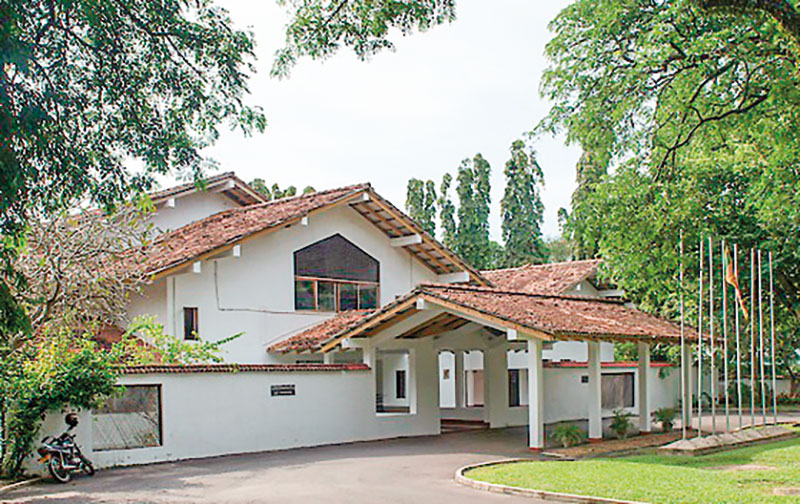
C. Narayanasuwami, the first Director of the then Agrarian Research and Training Institute (ARTI).
I am delighted to be associated with the fifty third anniversary celebrations of HARTI. I cherish pleasant memories of the relentless efforts made as the First Director to establish, incorporate, develop, direct, and manage a nascent institute in the 1970s amidst many challenges. The seven-year period as Director remains as the most formidable and rewarding period in my career as a development professional. I have been fortunate to have had a continuing relationship with HARTI over the last five decades. It is rarely that one who played a significant role in the establishment and growth of an institution gets an opportunity to maintain the links throughout his lifetime and provide messages on the completion of its fifth (I was still the director then), the 15th, 50th and 53rd anniversaries.
I had occasion also to acknowledge the contribution of the Institute on its 46th year when I released my book, ‘Managing Development: People, Policies and Institutions’ using HARTI auditorium and facilities, with the able support of the then director and staff who made the event memorable. The book contains a special chapter on HARTI.
On HARTI’s 15th anniversary I was called upon to offer some thoughts on the Institute’s future operations. The following were some of my observations then, “ARTI has graduated from its stage of infancy to adolescence….Looking back it gives me great satisfaction to observe the vast strides it has made in developing itself into a dynamic multidisciplinary research institution with a complement of qualified and trained staff. The significant progress achieved in new areas such as marketing and food policy, data processing, statistical consultancies, information dissemination and irrigation management, highlights the relevance and validity of the scope and objectives originally conceived and implemented”.
It may be prudent to review whether the recommendations contained in that message, specifically (a) the preparation of a catalogue of research findings accepted for implementation partially or fully during policy formulation, (b) the relevance and usefulness of information services and market research activities in enhancing farmer income, and (c) the extent to which the concept of interdisciplinary research- a judicious blend of socio-economic and technical research considered vital for problem-oriented studies- was applied to seek solutions to problems in the agricultural sector.
The thoughts expressed on the 15th anniversary also encompassed some significant management concerns, specifically, the need to study the institutional capabilities of implementing agencies, including the ‘human factor’ that influenced development, and a critical review of leadership patterns, management styles, motivational aspects, and behavioural and attitudinal factors that were considered vital to improve performance of agrarian enterprises.
A review of HARTI’s current operational processes confirm that farmer-based and policy-based studies are given greater attention, as for example, providing market information service for the benefit of producers, and undertaking credit, microfinance, and marketing studies to support policy changes.
The changes introduced over the years which modified the original discipline-based research units into more functional divisions such as agricultural policy and project evaluation division, environmental and water resources management division, and agricultural resource management division, clearly signified the growing importance attached to functional, action-oriented research in preference to the originally conceived narrowly focused discipline-based research activities.
HARTI has firmly established its place as a centre of excellence in socio-economic research and training with a mature staff base. It is pertinent at this juncture to determine whether the progress of HARTI’s operations was consistently and uniformly assessed as successful over the last five decades.
Anecdotal evidence and transient observations suggest that there were ups and downs in performance standards over the last couple of decades due to a variety of factors, not excluding political and administrative interventions, that downplayed the significance of socio-economic research. The success of HARTI’s operations, including the impact of policy-based studies, should be judged on the basis of improved legislation to establish a more structured socio-economic policy framework for agrarian development.
Looking Ahead
Fifty-three years in the life of an institution is substantial and significant enough to review, reflect and evaluate successes and shortcomings. Agrarian landscapes have changed over the last few decades and national and global trends in agriculture have seen radical transformation. Under these circumstances, such a review and reflection would provide the basis for improving organisational structures for agricultural institutions such as the Paddy Marketing Board, development of well-conceived food security plans, and above all, carefully orchestrated interventions to improve farmer income.
New opportunities have arisen consequent to the recent changes in the political horizon which further validates the role of HARTI. HARTI was born at a time when Land Reform and Agricultural Productivity were given pride of place in the development programs of the then government. The Paddy Lands Act provided for the emancipation of the farming community but recent events have proven that the implementation of the Paddy Lands Act has to be re-looked at in the context of agricultural marketing, agricultural productivity and income generation for the farming community.
Farmers have been at the mercy of millers and the price of paddy has been manipulated by an oligopoly of millers. This needs change and greater flexibility must be exercised to fix a guaranteed scale of prices that adjust to varying market situations, and provide adequate storage and milling facilities to ensure that there is no price manipulation. It is time that the Paddy Lands Act is amended to provide for greater flexibility in the provision of milling, storage and marketing services.
The need for restructuring small and medium scale enterprises (SMEs) recently announced by the government warrants greater inputs from HARTI to study the structure, institutional impediments and managerial constraints that inflict heavy damages leading to losses in profitability and organisational efficiency of SMEs.
Similarly, HARTI should look at the operational efficiency of the cooperative societies and assess the inputs required to make them more viable agrarian institutions at the rural level. A compact research exercise could unearth inefficiencies that require remedial intervention.
With heightened priority accorded to poverty alleviation and rural development by the current government, HARTI should be in the forefront to initiate case studies on a country wide platform, perhaps selecting areas on a zonal basis, to determine applicable modes of intervention that would help alleviate poverty.
The objective should be to work with implementing line agencies to identify structural and institutional weaknesses that hamper implementation of poverty reduction and rural development policies and programs.
The role played in disseminating marketing information has had considerable success in keeping the farming community informed of pricing structures. This should be further expanded to identify simple agricultural marketing practices that contribute to better pricing and income distribution.
HARTI should consider setting up a small management unit to provide inputs for management of small-scale agrarian enterprises, including the setting up of monitoring and evaluation programs, to regularly monitor and evaluate implementation performance and provide advisory support.
Research and training must get high level endorsement
to ensure that agrarian policies and programs constitute integral components of the agricultural development framework. This would necessitate a role for HARTI in central planning bodies to propose, consider and align research priorities in line with critical agricultural needs.
There is a felt need to establish links with universities and co-opt university staff to play a role in HARTI research and training activities-this was done during the initial seven-year period. These linkages would help HARTI to undertake evaluative studies jointly to assess impacts of agrarian/agricultural projects and disseminate lessons learned for improving the planning and execution of future projects in the different sectors.
In the overall analysis, the usefulness of HARTI remains in articulating that research and analysis are crucial to the success of implementation of agrarian policies and programs.
In conclusion, let us congratulate the architects and the dynamic management teams and staff that supported the remarkable growth of HARTI which today looks forward to injecting greater dynamism to build a robust institution that would gear itself to meeting the challenges of a new era of diversified and self-reliant agrarian society. As the first director of the Institute, it is my wish that it should grow from strength to strength to maintain its objectivity and produce evidence-based studies that would help toward better policies and implementation structures for rural transformation.
Features
Keynote Speech at the Launch of The Ceylon Journal, by Rohan Pethiyagoda
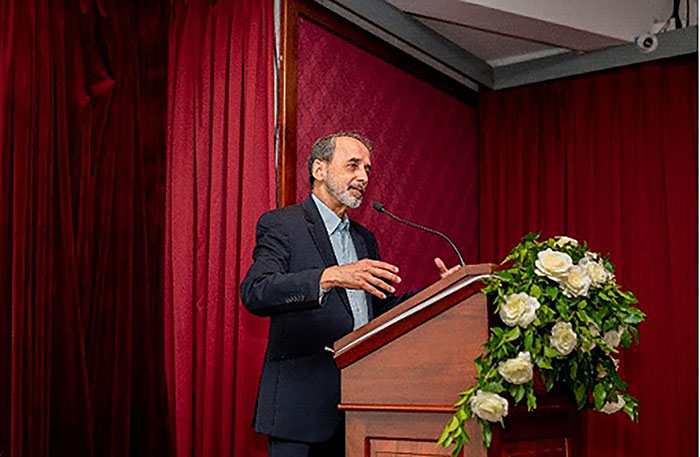
“How Rubber Shaped our Political Philosophy”
The Ceylon Journal was launched last August. Its first issue is already out of print. Only a handful of the second issue covering new perspectives of history, art, law, politics, folklore, and many other facets of Sri Lanka is available. To reserve your very own copy priced Rs. 2000 call on 0725830728.
Congratulations, Avishka [Senewiratne]. I am so proud of what you have done. Especially, Ladies and Gentlemen, to see and hear all of us stand up and actually sing the National Anthem was such a pleasure. Too often on occasions like this, the anthem is played, and no one sings. And we sang so beautifully this evening that it brought tears to my eyes. It is not often we get to think patriotic thoughts in Sri Lanka nowadays: this evening was a refreshing exception.
I’m never very sure what to say on an occasion like this, in which we celebrate history, especially given that I am a scientist and not a historian. It poses something of a challenge for me. Although we are often told that we must study history because it repeats itself, I don’t believe it ever does. But history certainly informs us: articles such as those in The Ceylon Journal, of which I read an advance copy, help us understand the context of our past and how it explains our present.
I want to take an example and explain what I am on about. I’m going to talk about rubber. Yes rubber, as in ‘eraser’, and how it crafted our national political identity, helping, even now seven decades later, to make ‘capitalism’ a pejorative.
As I think you know already, rubber came into general use in the middle of the 19th century. Charles Macintosh invented the raincoat in 1824 by placing a thin sheet of rubber between two sheets of fabric and pressing them together. That invention transformed many things, not least warfare. Just think of Napoleon’s invasion of Russia in the winter of 1812. His troops did that without any kind of waterproof clothing. Some 200,000 of them perished, not from bullets but from hypothermia. Waterproof raincoats could have saved thousands of lives. Not long after rubber came to be used for waterproofing, we saw the first undersea telegraph cable connecting Europe to North America being laid in the 1850s. When the American civil war broke out in 1860, demand for rubber increased yet further: the troops needed raincoats and other items made from this miracle material.
At that time rubber, used to be collected from the wild in the province of Pará in Northern Brazil, across which the Amazon drains into the Atlantic. In 1866, steamers began plying thousands of kilometres upriver, to return with cargoes of rubber harvested from the rainforest. Soon, the wild trees were being tapped to exhaustion and the sustainability of supply became doubtful.
Meanwhile, England was at the zenith of its colonial power, and colonial strategists thought rather like corporate strategists do today. The director of the Kew Gardens at the time, Joseph Hooker, felt there might be one day be a greater potential for rubber. He decided to look into the possibility of cultivating the rubber tree, Hevea brasiliensis, in Britain’s Asian colonies. So, he dispatched a young man called Henry Wickham to the Amazon to try to secure some seeds. In 1876, Wickham returned to Kew with 70,000 rubber seeds. These were planted out in hothouses in Kew and by the end of that year, almost 2000 of them had germinated.
These were dispatched to Ceylon, only a few weeks’ voyage away now, thanks to steamships and the Suez Canal. The director of the Peradeniya Botanic Garden at the time was George Henry Kendrick Thwaites, a brilliant systematic botanist and horticulturalist. Thwaites received the seedlings and had to decide where to plant them. He read the available literature—remember, this was 1876: there was no internet—and managed to piece together a model of the climatic conditions in the region of the Amazonian rainforest to which rubber was native. He decided that the plants would need an elevation of less than 300 metres and a minimum annual rainfall of at least 2000mm. In other words, the most suitable region for rubber would be an arc about 30 kilometres wide, extending roughly from Ambalangoda to Matale. Despite his never having seen a rubber plant until then, astonishingly, he got it exactly right.
Thwaites settled on a site in the middle of the arc, at Henarathgoda near Gampaha. That became the world’s first rubber nursery: the first successful cultivation of this tree outside Brazil. The trees grew well and, eight years later, came into seed. Henry Trimen, Thwaites’ successor, used the seeds to establish an experimental plantation near Polgahawela and also shared seeds with the Singapore Botanic Garden. Those would later become the foundation of the great Malaysian rubber industry.
But up to that time, Sri Lanka’s rubber plantation remained a solution looking for a problem. Then, in 1888, the problem arrived, and from a completely unexpected quarter: John Dunlop invented the pneumatic tire. Soon, bicycles came to be fitted with air-filled tires, followed by motorcars. In 1900, the US produced just 5,000 motorcars; by 1915, production had risen to half a million. The great rubber boom had begun.
Meanwhile, the colonial administration in Ceylon had invited investors to buy land and start cultivating rubber to feed the growing international demand. But by the early 1890s, three unusual things had happened. First, with the collapse of the coffee industry in the mid-1870s, many British investors had been bankrupted. Those who survived had to divert all their available capital into transitioning their failing coffee plantations into tea. They were understandably averse to risk. As a result, the British showed little interest in this strange tree called rubber that had been bought from Brazil.
Second, a native Sri Lankan middle class had by then emerged. The Colebrooke-Cameron reforms had led to the establishment of the Royal academy, later Royal College, by 1835. Other great schools followed in quick succession. From the middle of the 19th century, it was possible for Sri Lankans to get an education and get employment in government service, become professionals, doctors, lawyers, engineers, civil servants, clerks, and so on. And so, by the 1890s, a solid native middle class had emerged. The feature that defines a middle class, of course, is savings, and these savings now came to be translated into the capital that founded the rubber industry.
Third, the British had by then established a rail and road network and created the legal and commercial institutions for managing credit and doing business—institutions like banks, financial services, contract law and laws that regulated bankruptcy. They had made the rules, but by now, Sri Lankans had learned to play the game. And so, it came to be that Sri Lankans came to own a substantial part of the rubber-plantation industry very early in the game. By 1911, almost 200,000 acres of rubber had been planted and world demand was growing exponentially.
In just one generation, investors in rubber were reaping eye-watering returns that in today’s money would equate to Rs 3.6 million per acre per year. It was these people who, together with the coconut barons, came to own the grand mansions that adorn the poshest roads in Cinnamon Gardens: Ward Place, Rosmead Place, Barnes Place, Horton Place, and so on. There was an astonishingly rapid creation of indigenous wealth. By 1911, the tonnage at shipping calling in Sri Lankan ports—Colombo and Trincomalee—exceeded nine million tons, making them collectively the third busiest in the British Empire and the seventh busiest in the world. By comparison, the busiest port in Europe is now Rotterdam, which ranks tenth in the world.
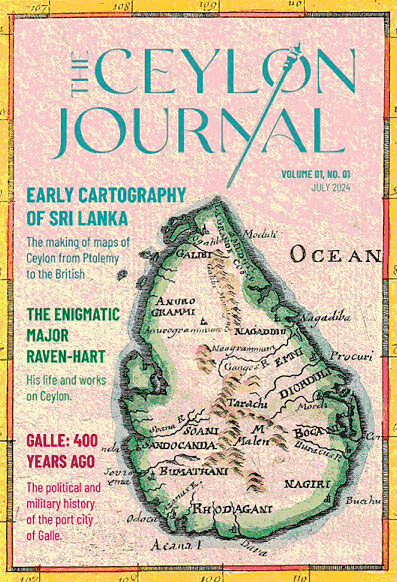 We often blame politicians for things that go wrong in our country and God knows they are responsible for most of it. But unfortunately for us, the first six years of independence, from 1948 to 1954, were really unlucky years for Sri Lanka. As if successive failed monsoons and falling rice crops weren’t bad enough, along came the Korean war. In the meantime, the Sri Lankan people had got used to the idea of food rations during the war and they wanted rations to be continued as free handouts. Those demands climaxed in the ‘Hartal’ of 1953, a general strike demanding something for nothing. Politicians were being forced to keep the promises they had made when before independence, that they would deliver greater prosperity than under the British.
We often blame politicians for things that go wrong in our country and God knows they are responsible for most of it. But unfortunately for us, the first six years of independence, from 1948 to 1954, were really unlucky years for Sri Lanka. As if successive failed monsoons and falling rice crops weren’t bad enough, along came the Korean war. In the meantime, the Sri Lankan people had got used to the idea of food rations during the war and they wanted rations to be continued as free handouts. Those demands climaxed in the ‘Hartal’ of 1953, a general strike demanding something for nothing. Politicians were being forced to keep the promises they had made when before independence, that they would deliver greater prosperity than under the British.
So, by 1949, D. S. Senanayake was forced to devalue the rupee, leading to rapid price inflation. Thankfully we didn’t have significant foreign debt then, or we might have had to declare insolvency much earlier than we finally did, in 2022. And then, because of failing paddy harvests, we were forced to buy rice
from China, which was in turn buying our rubber. But as luck would have it, China entered the Korean war, causing the UN, at the behest of the US, to embargo rubber exports to China.
This placed the D. S. Senanayake and John Kotelawala governments in an impossible predicament. There was a rice shortage; people were demanding free rice, and without rubber exports, there was no foreign exchange with which to buy rice. Kotelawala flew to Washington, D.C., to meet with President Eisenhower and plead for either an exemption from the embargo or else, for the US to buy our rubber. Despite Sri Lanka having provided rubber to the Allies at concessionary prices during the war and having supported the Allies, Eisenhower refused. British and American memories were short indeed. In India, Mahatma Gandhi and the Congress Party had chosen the moment, in August 1942 when Japan invaded Southeast Asia and were poised to invade Bengal, to demand that the British quit India, threatening in the alternative that they would throw their lot in with the Japanese. The Sri Lankan government, by contrast, had stood solidly by the Allies. But now, those same allies stabbed the fledgling nation in the chest. Gratitude, it seemed, was a concept alien to the West.
In these circumstances, Sri Lanka had no choice but to break the UN embargo and enter into a rice-for-rubber barter agreement with China. This resulted not only in the US suspending aid and the supply of agricultural chemicals to Sri Lanka, but also invoking the Battle Act and placing restrictions on US and UK ships calling at the island’s ports.
Understandably, by 1948, Sri Lankans entertained a strong disdain for colonialism. With the Cold War now under way, the USSR and China did all they could to split countries like Sri Lana away not just from their erstwhile colonial masters but also the capitalist system. If any doubt persisted in the minds of Sri Lankan politicians, Western sanctions put an end to that. The country fell into the warm embrace of the communist powers. China and the USSR were quick to fill the void left by the West, and especially in the 1950s, there was good reason to believe that the communist system was working. The Soviet economy was seeing unprecedented growth, and that decade saw them producing hydrogen bombs and putting the first satellite, dog and man in space.
As a consequence of the West’s perfidy in the early 1950s, ‘Capitalism’ continues to have pejorative connotations in Sri Lanka to this day. And it resulted in us becoming more insular, more inward looking, and anxious to assert our nationalism even when it cost us dearly.
Soon, we abolished the use of English, and we nationalized Western oil companies and the plantations. None of these things did us the slightest bit of good. We even changed the name of the country in English from Ceylon to Sri Lanka. Most countries in the world have an international name in addition to the name they call themselves. Sri Lanka had been ‘Lanka’ in Sinhala throughout the colonial period, even as its name had been Ceylon in English. The Japanese don’t call themselves Japan in their own language, neither do the Germans call themselves Germany. These are international names for Nihon and Deutschland, just like Baharat or Hindustan is what Indians call India. But we insisted that little Sri Lanka will assert itself and insist what the world would call us, the classic symptom of a massive inferiority complex. While countries like Singapore built on the brand value of their colonial names, we erased ours from the books. Now, no one knows where Ceylon tea or Ceylon cinnamon comes from.
Singapore is itself a British name: it should be Sinha Pura, the Lion City, a Sanskrit name. But Singapore values its bottom line more than its commitment to terminological exactitude. Even the name of its first British governor, Sir Stamford Raffles, has become a valued national brand. But here in Sri Lanka, rather than build on our colonial heritage, not the least liberal values the British engendered in us, together with democracy and a moderately regulated economy, we have chosen to deny it and seek to expunge it from our memory. We rejected the good values of the West along with the bad: like courtesy, queuing, and the idea that corruption is wrong.
We have stopped fighting for the dignity of our land, and I hope that as you read the articles in The Ceylon Journal that are published in the future, we will be reminded time and time again of the beautiful heritage of our country and how we can once again find it in ourselves to be proud of this wonderful land.
-
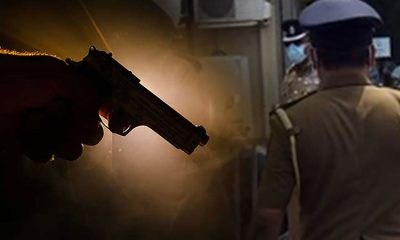
 News4 days ago
News4 days agoSuspect injured in police shooting hospitalised
-

 Features5 days ago
Features5 days agoRobbers and Wreckers
-
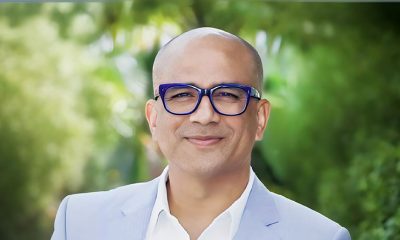
 Business4 days ago
Business4 days agoSanjiv Hulugalle appointed CEO and General Manager of Cinnamon Life at City of Dreams Sri Lanka
-
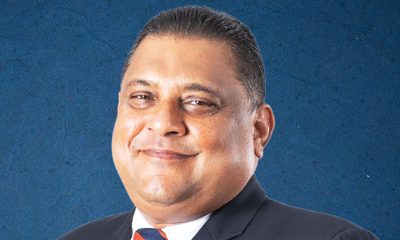
 Business5 days ago
Business5 days agoBhathiya Bulumulla – The Man I Knew
-
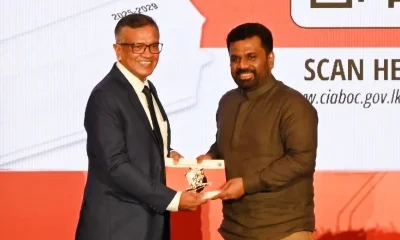
 Business6 days ago
Business6 days agoNational Anti-Corruption Action Plan launched with focus on economic recovery
-

 Features3 days ago
Features3 days agoLiberation Day tariffs chaos could cause permanent damage to US economy, amid global tensions
-
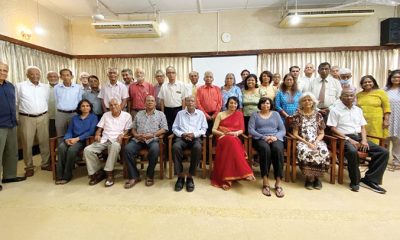
 Features3 days ago
Features3 days agoMinds and Memories picturing 65 years of Sri Lankan Politics and Society
-
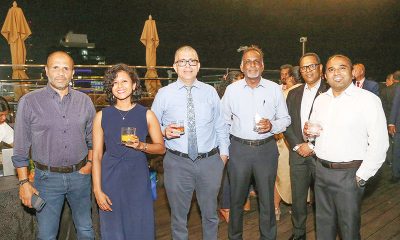
 Business3 days ago
Business3 days agoMembers’ Night of the Sri Lanka – Russia Business Council of The Ceylon Chamber of Commerce











